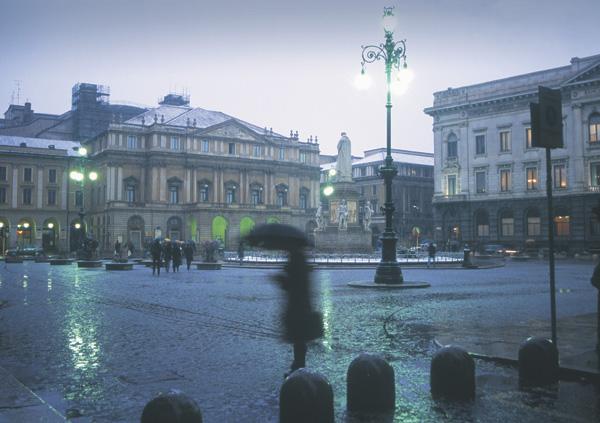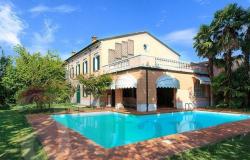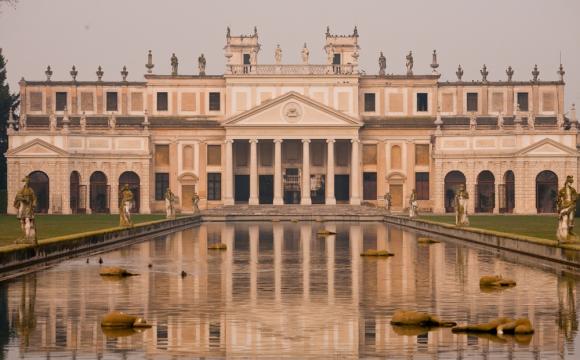years, gives us the insider’s view of the city people love to hate.
Many moons ago, when I was first toying with the idea of moving to Italy, I asked someone in London for advice. ‘Well,’ he said, ‘it’s pretty simple, really: if you go to one of the beautiful cities, like Rome, Florence, or Venice, then it’ll be hard to find work, as that’s where everyone wants to go. If, on the other hand, you’re prepared to try one of the ugly industrial cities, like Turin or Milan, then it’ll be a lot easier.’
Encouraged by this somewhat back-handed endorsement, I went to Milan and found that my advisor (whose name I have long since forgotten) was right. Nor was he referring just to employment prospects for aspiring ex-pats: Milan and Turin are where Italians of every type migrate in order to find work. Milan’s first industrial boom (which is the subject of an excellent exhibition at the Palazzo Reale: Il Mondo Nuovo – the New World – until 28th February) took place at the start of the 20th century, while the second came about with Italy’s ‘economic miracle’ in the 1950s and 1960s. Today Italians still move to Milan to work in its ‘post-industrial service sectors,’ but the predominant immigrant groups are from East European and Third World countries, making the city something of a multi-ethnic melting pot.
If that sounds rather American, then this is intentional. If Rome, thanks to its vast bureaucratic machines (created by the state, the church and assorted international agencies) and TV and film industries, is a combination of Washington, D.C. and Los Angeles, then Milan is Italy’s New York. Like New York, it is home to its country’s stock exchange and financial hub; it is similarly dominant in terms of fashion, design and advertising, and it also runs the nation’s music industry, even if the artists themselves invariably hail from elsewhere. And, as if to emphasise the similarities between the two cities, Milan has its own admittedly miniature version of the World Trade Center attacks. In April 2002 a wayward two-seater plane mysteriously crashed into the Pirelli Building, killing the pilot and two office workers and creating panic in the streets below. The Pirelli building, like the Twin Towers, is a symbol of its city: it was built during the post-war boom and for many years it was Europe’s tallest skyscraper.
The similarities between Milan and New York also extend to their inhabitants. The Milanese, like their counterparts in the Big Apple, are dynamic, hard-working, ambitious and, ultimately, self-obsessed. Even in their leisure hours their favourite topic of conversation is themselves and their careers, which tends to make them less entertaining company than the more laid-back Romans. Nobody personifies the Milanese character better than Italy’s current prime mini-ster, the Napoleonically diminutive media magnate Silvio Berlusconi, who is the archetypal ‘self-made man who worships his creator’.
Being Somewhere Else
As a tourist attraction, however, Milan is sadly not in the same league as New York. Indeed its appeal as a city is its proximity to more beautiful places. The northern Italian lakes like Maggiore and Como (which, incidentally, are more popular with the British, Germans and French than the Italians themselves, who consider them ‘melancholic’) are only an hour away, while, if you want to go skiing in the mountains in winter, or swimming and sailing off the Ligurian coast in the summer, then you can get there in two hours. As a result, the locals tend to flee the city at weekends, making the Sunday night ‘rientro,’ or re-entry, to Milan a traffic nightmare: if you can reach your weekend getaway on Italy’s unbelievably cheap (compared to the UK's) rail network, then so much the better. If Milan’s closeness to areas of outstanding natural beauty is an undoubted asset, then it creates a strange attitude. As a friend who moved to the city from Genoa once observed: ‘Whenever the weather is beautiful in Milan you hear people say, ‘Oh, this is the sort of day you should be in the mountains,’ or ‘this is the sort of day to go the seaside.’ People never think this a day to be in Milan. It’s as if they always want to be somewhere else.’
Milan’s Attractions
If you are unable to go somewhere else, then there are in fact quite a few things to do in Milan. The basic attractions can be covered fairly quickly and, as is the case with many Italian cities, they are within walking distance of each other. Strolling around the centre of Milan is actually quite agreeable as the city, in spite of its unmanageable traffic and its ‘Third World’ levels of air pollution, has a surprising number of pedestrian precincts. The obvious starting point is the Duomo (cathedral) and the large piazza in front of it, both of which are impressive. You should also make the effort to climb the stairs to the Duomo’s roof, where you can enjoy a bird’s eye view of Milan and, if it’s a nice day, the Alps. From the piazza you can enter the elegant Galleria Vittorio Emanuele II, which is said to have been ‘the world’s first shopping mall.’ This will take you to the famous opera house, La Scala. Actually seeing a performance at the Scala has ever been easy. The ticket sales system, as with that for the city’s theatres, seems to be deliberately complicated.
If La Scala is a world player for opera buffs, then Via Montenapoleone is the same for fashion victims. Of course you might want to think twice about buying something but, if you want to window shop, or even see characters like Giorgio Armani wandering about, then it’s well worth a trip. Via Montenapoleone is one of the four streets that make up Milan’s ‘fashion square,’ or quadrilatero della moda. Versace and Dolce & Gabbana also have their headquarters here, although Gianfranco Ferrè has since moved to the Brera District. The other streets in the quadilatero, which include the quieter, cobbled, Via della Spiga, are also worth including in your constitutional. If, on the other hand, you want some bargains, it’s only four stops (from the Duomo, three from Montenapoleone) on the ‘yellow line’ subway to Stazione Centrale. Here, in addition to admiring the massive station’s spectacularly over-the-top Fascist architecture (complete with bas-reliefs featuring S.P.Q.R. signs and wolves suckling Romulus and Remus), not to mention the battered Pirelli building, you might find some wholesale bargains in the surrounding streets. The current trend is, however, to drive out of town, to places like Serravalle Scrivia in the Tortonese, on the way to Genova, where designer label clothes are sold at outlets that offer large discounts.
Arts and Antiques
The afore-mentioned Brera district, which has been described as ‘the heart of Milan’ is another must and can be reached by walking up Via Verdi, alongside La Scala. Here the art-lovers among you will enjoy the collection at the Pinacoteca, which covers Italian painting over the centuries, while the small, yet lively streets in front, are great places to hang out and watch the world go by, especially if there’s an open-air antiques or art fair going on. If you still feel like walking, then the Castello Sforzesco is nearby and here you can either visit its collections, or else go for a stroll in the adjoining Parco Sempione, one of the few Milanese parks worth bothering about. The park also houses the Triennale, a museum that stages design exhibitions of international quality, even though, as is often the case with cultural activities in Milan, they receive minimal publicity.
The same cannot be said of Milan’s most famous tourist attraction, Leonardo da Vinci’s Last Supper fresco (or affresco, to use the correct Italian term) at the Santa Maria delle Grazie church in Corso Magenta, which is a short tram ride from the Duomo. As with La Scala, getting in requires great patience, but you will know you’re in the right area when a Japanese tourist stops you and asks you how to get there. The Last Supper itself is vaguely disappointing, but this can be made up for by seeing the adjoining church and its pretty ‘Bramante’s cloister.’
Crowded Canals
The last stop in Milan is the ‘Navigli,’ or canals, which can be reached from the centre either by tram or subway (Porta Genova on the ‘green line’). The canals were built in the 15th century, largely in order to bring marble to Milan for the construction of the Duomo, as the city didn’t have any rivers that were large enough. As a result, Milan had a large canal network until 1930, when most of it was covered up. Only the main points of entry, the Naviglio Grande and the Naviglio Pavese, to the south, and the Martesana to the north-east, were spared. The southern section, around Porta Genova, remained a working-class district but, from the 1980s onwards, it underwent the gentrification process as arty and business types were lured by its low real estate prices. In many respects the Navigli are a victim of their own success and today they are over-crowded, yet they are, along with the Brera, still a centre for Milanese night life. Furthermore, every last Sunday of the month, the Naviglio Grande is taken over by a huge antiques and general knick-knacks fair, which will enable you to find bargains, or at least to see unusual characters.
Sleeping and Eating
Hotels in Milan are something of a problem, as they vary from spectacularly expensive five-star affairs, which can be found throughout the centre, to cheap and not particularly cheerful dives (mainly around Stazione Centrale), with not a great deal in between. There are, of course, exceptions, such as the Sant’Ambreous, in Viale Papiniano, but this is good for the price, rather than great. Restaurants on the other hand, are another matter, as the city has dozens of superb eateries, which have always been less expensive than London’s. One favourite (and this is admittedly for special occasions) is the Osteria del Binari in Via Tortona. Literally, ‘the hostelry of the tracks,’ it sits next to the railway bridge at the Porta Genova station and, from the outside, you could be forgiven for thinking it was a small cafe. Yet a colleague from London, whose job description includes wining and dining clients in several continents, thinks it is one of the best restaurants in the world. As is the case with many of Milan’s treasures, which include ancient courtyards and splendid gardens hidden by the buildings they belong to, you could walk right past without knowing it was there.








